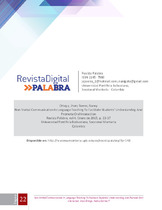| dc.contributor.author | Ortega Sabas, John Jorge | |
| dc.contributor.author | Gómez Torres, Nancy | |
| dc.coverage.spatial | Seccional Medellín | spa |
| dc.date.accessioned | 2020-11-30T14:05:03Z | |
| dc.date.available | 2020-11-30T14:05:03Z | |
| dc.date.issued | 2015 | |
| dc.identifier.uri | http://hdl.handle.net/20.500.11912/6759 | |
| dc.description | p. 22 - 37 | spa |
| dc.description.abstract | The present study focuses on the inclusion of conscious non-verbal communication as a technique to facilitate students’ understanding of the target language. This experimental research comes up after a process of observation, carried out in a public school in the north of Córdoba, where it was found that beginner language learners struggle to grasp what was being communicated by the teacher. In order to gives solution to this problem, the researcher decided to explore the impact that intentional non-verbal cues might have on the language classroom in both the teacher and the students. To make this investigation valid there were chosen a sample population of eight participants, seven students and one English teacher, which become objects of observations for a pair of weeks. Then, interviews and questionnaires were administered; and finally, a rigorous analysis based on the triangulation perspective allows coming up with this finding: The adoption of certain facial gestures, body movements and vocal sounds not only help learners to understand the target language but also to increase rapport between the Non-Verbal Communication in Language Teaching to Facilitate Students’ Understanding and Promote Oral Interaction ( Artículo Investigación) Página 24 teacher and the students and to develop the learners’ communicative competence. Due to this great impact, the researcher considers that nonverbal communication plays a highly important role in the field of language teaching and learning, and he suggests teacher trainers to include in their training programs, sessions related to the use of aspects of nonverbal behaviors in the teaching of English since by doing this they will be making an essential contribution to the development of the language teaching process in the region. | spa |
| dc.description.abstract | Este estudio se enfoca en la inclusión del lenguaje no verbal de manera consciente como una técnica que facilita a los estudiantes la comprensión del lenguaje objeto de estudio. Está investigación experimental surgió de un proceso de observación, llevado a cabo en una escuela pública situada en el norte de Córdoba, donde se encontró que los estudiantes presentaban dificultad para entender el mensaje que estaba siendo comunicado por el profesor de lenguas. Para dar solución a esta problemática, se decidió explorar el impacto que la comunicación no verbal utilizada de manera intencional podría tener en los estudiantes y el profesor dentro del salón de clases de lengua extranjera. Para validar esta investigación se seleccionó una muestra representativa de la población compuesta por siete estudiantes y un profesor de inglés, los cuales fueron observados por varias semanas. Luego, se les hicieron entrevistas y aplicaron encuestas para hacer un riguroso análisis basado en perspectiva triangular de datos, la cual permitió reportar el siguiente hallazgo: La adopción de ciertos gestos faciales, movimientos corporales y sonidos vocales no solo facilita a los estudiantes comprender la lengua objeto de estudio, además contribuye a crear una buena relación en el salón de clase y también ayuda a desarrollar la competencia comunicativa. Debido a este gran descubrimiento, el investigador considera que la comunicación no verbal utilizada de forma intencional juega un rol importante en el campo de la enseñanza y aprendizaje de lenguas extranjeras, por lo tanto sugiere a los maestros formadores incluir dentro de sus capacitaciones, apartes relacionado con el uso de aspectos de la comunicación no verbal en la enseñanza del inglés ya que con esto se estaría haciendo un aporte significativo en el desarrollo del proceso de enseñanza de esta lengua dentro de la región. | spa |
| dc.format.mimetype | application/pdf | |
| dc.language.iso | eng | |
| dc.publisher | Universidad Pontificia Bolivariana | spa |
| dc.relation.ispartof | Revista Digital Palabra | spa |
| dc.rights | Attribution-NonCommercial-NoDerivatives 4.0 International | * |
| dc.rights.uri | http://creativecommons.org/licenses/by-nc-nd/4.0/ | * |
| dc.subject | Non-verbal communication | spa |
| dc.subject | Human interaction | spa |
| dc.subject | Interpretation of messages | spa |
| dc.subject | Stimulating meaning | spa |
| dc.subject | Gestures | spa |
| dc.subject | Behaviors | spa |
| dc.subject | Oral cues | spa |
| dc.subject | Kinesics | spa |
| dc.title | Non-verbal communication in language teaching to facilitate students’ understanding and promote oral interaction | spa |
| dc.type | article | spa |
| dc.rights.accessRights | openAccess | spa |
| dc.type.hasVersion | publishedVersion | spa |
| dc.description.sectional | Medellín | spa |
| dc.identifier.instname | instname:Universidad Pontificia Bolivariana | spa |
| dc.identifier.reponame | reponame:Repositorio Institucional de la Universidad Pontificia Bolivariana | spa |
| dc.identifier.repourl | repourl:https://repository.unab.edu.co/ | |


